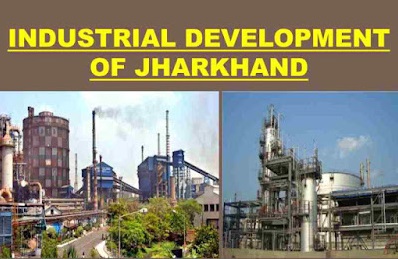

The new state of Jharkhand, widely acclaimed as the region of future, has enormous potentialities for industrialization. With its large deposits of minerals, it provides a solid launching pad for all kinds of industries.
With 40% of nations mineral reserves, the state government is committed to rapid development by leveraging the Location Advantage, combined with visionary Political Leadership and a proactive Industrial Policy.
Organisations like Industrial Area Development Authorities {Ranchi Industrial Area Development Authority (RIADA), Adityapur Industrial Area Development Authority (AIADA) & Bokaro Industrial Area Development Authority (BIADA)}, State Khadi Board, Jharkhand Industrial Infrastructure Development Corporation (JIIDCO) and JHARCRAFT are making significant contribution in industrialization of the State and are cash surplus. But desired progress in areas like IT, Biotechnology, Special Economic Zone (SEZ), Food Processing, Down Stream Processing etc is yet to be achieved.
Considerable progress in industrialization has been achieved during the policy period. As many as 26 mega industries, 106 large and medium industries and 18,109 micro and small industries have been set up in the State during the period with an approximate investment of Rs 28,424.06 crore and about 63,000 people thus far got employment in these industries. It has contributed to the revenue collection of the State besides improving the quality of life in certain pockets like Jamshedpur-Saraikela-Chaibassa, Ramgarh-Patratu-Hazaribagh, Latehar-Chandwa, Ranchi-Lohardaga, Bokaro-Chandankiyari-Dhanbad-Giridih etc.
To ensure regular and mega investment, the State has been able to convince the ambassadors of industries to choose Jharkhand as preferred investment destination. Accordingly, major industrial houses have inked MoUs with the State Government. Several bottlenecks and difficulties notwithstanding, the industries have been able to acquire about 8,000 acres of land through direct negotiation with raiyats. In addition the State Government has also been able to provide approximately 3000 acres of land to these industries including power units. Around 17 mega industries have already come into production and several other industrial units are likely to be commissioned during the financial year 2011-12.
Steel production in the State has increased from 8 million tonnes (MT) to over 12 million tonnes per annum during the 11th Plan period. Jharkhand is presently producing about 20-25% of total steel being produced in the country. With the proposed expansion of a number of integrated steel plants, the State will be producing over 25 MT of steel and thus will turn to be a steel-hub of India. Even various types of auto grade steels, which were earlier being imported, are now being produced within the State. Similarly the production of alumina in the State has increased from about 80,000 metric tonnes to over 200,000 metric tonnes. Significant enhancement could also be achieved in cement and clinker production.
There has been a phenomenal growth in Sericulture Sector. A record growth in production of 716 metric tonne of Tasar Silk has been achieved during 2010-11 compared to the production of less than 100 metric tonne till 2006 and now approximately 1.25 lakh employment has been generated in the sector.
Growth in Mining and Quarrying has also been observed in the State. The output from this sector has increased from Rs 6523.4 crore in 2003-04 to Rs 10170.5 crore in 2009-10.
There has been almost three times growth in Gross State Domestic Product (GSDP) of the State which is an indicator of its fast growth. GSDP of Jharkhand at current prices has increased from Rs 39191.09 crore in 2000-01 to about Rs 120010.20 crore in 2010-11. Similarly the per capita income of Jharkhand has also increased from Rs 14392 in 2001-02 to Rs 38350 in 2010-11.
However, there is a need to boost the economic activities to sustain the current level of growth and achieve even better pace of development. Since the State is endowed with rich mineral resources, its optimal utilization including value addition is essential for maximizing the benefit of local people.
There has been large scale change in industrial environment due to economic liberalization, privatization and globalization. Strong emphasis is being placed on Micro, Small and Medium Enterprises (MSME). Clusterisation is being promoted, pollution norms have become more stringent, concept of ‘go’ and ‘no go’ zoning has been developed for mining clearances etc. Value Added Tax (VAT) regime has been implemented and is likely to be further replaced by Goods and Service Tax (GST).
Enough of learning experience has been gathered from implementation of Jharkhand Industrial Policy 2001. Organisations like Industrial Area Development Authorities {Ranchi Industrial Area Development Authority (RIADA), Adityapur Industrial Area Development Authority (AIADA) & Bokaro Industrial Area Development Authority (BIADA)}, State Khadi Board, Jharkhand Industrial Infrastructure Development Corporation (JIIDCO) and JHARCRAFT are making significant contribution in industrialization of the State and are cash surplus. But desired progress in areas like IT, Biotechnology, Special Economic Zone (SEZ), Food Processing, Down Stream Processing etc is yet to be achieved.
Further, investors trying to set up large / mega industries in the State are facing difficulties in acquisition of land.
Jharkhand ranks first in production of Tasar Silk in the country. In order to maintain the leading edge and rejuvenate existing rural industries including sericulture, handloom, handicraft, khadi, textile etc., it is envisaged to assist them in modernization/technological upgradation and provide necessary common facilities, backward and forward linkages including product design, marketing support etc. so as to make them globally competitive and their product remunerative.
The present policy aims at creating industry-friendly environment for maximizing investment especially in mineral and natural resource based industries, MSMEs, infrastructure development and rehabilitation of viable sick units. The objective here is to maximize the value addition to state's natural resources by setting up industries across the state, generating revenue and creating employment.
In view of the above, this policy has been drafted after intensive interaction with representatives of industries, industry association, investors, subject experts etc and efforts have been made to accommodate their views. It is expected that implementation of the policy will facilitate industrialization of the State, generate employment and add to its overall growth.
References: ^ "Department of Industry Jharkhand"